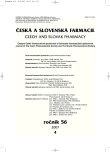The effect of polymeric dispersion type on the release of diclofenac sodium from coated pellets
Authors:
K. Krejčová 1; M. Rabišková 1; D. Vetchý 1; V. Tomášek 2; A. Prokopová 2
Authors‘ workplace:
Veterinární a farmaceutická univerzita Brno, Farmaceutická fakulta, Ústav technologie léků
1; Zentiva, a. s. Praha
2
Published in:
Čes. slov. Farm., 2007; 56, 190-199
Category:
Original Articles
Overview
Recently, coated pellets have gained attention of the pharmaceutical industry as they represent a relatively easy way leading to controlled drug release. Pellets of appropriate properties containing approx. 40 % of diclofenac sodium were prepared by roto-agglomeration. For the coating, two different aqueous dispersions (Surelease® and Eudragit®RS 30 D) were selected. Generally, the drug release rate slowed down as the coating load increased from 10 to 22 %. However, big differences between diclofenac sodium release from pellets coated with Surelease® and Eudragit®RS30D at equivalent coating loads were observed. Although Eudragit®RS 30 D provided membranes successfully controlling drug release over an extended period of 24 hours, the coating process with Surelease® led to a film of a very poor quality. Faster release from ethyl cellulose coated pellets could be explained in terms of a higher solubility of diclofenac sodium in alkaline aqueous dispersion of ethyl cellulose and its migration into the coat during the coating process and/or the unsatisfactory curing of the ethyl cellulose film. Therefore possible interactions between the coating and the drug should be always considered as suggested in this study.
Key words:
coated pellets – diclofenac sodium – Surelease® – Eudragit® RS 30 D
Labels
Pharmacy Clinical pharmacologyArticle was published in
Czech and Slovak Pharmacy

2007 Issue 4
Most read in this issue
- Interactions of food and dietary supplements with drug metabolising cytochrome P450 enzymes
- Voltage gated calcium channels: structure, characteristics and terminology
- Applications of molecularly imprinted polymers in analytical and pharmaceutical chemistry
- T-2 toxin: occurrence and detection
